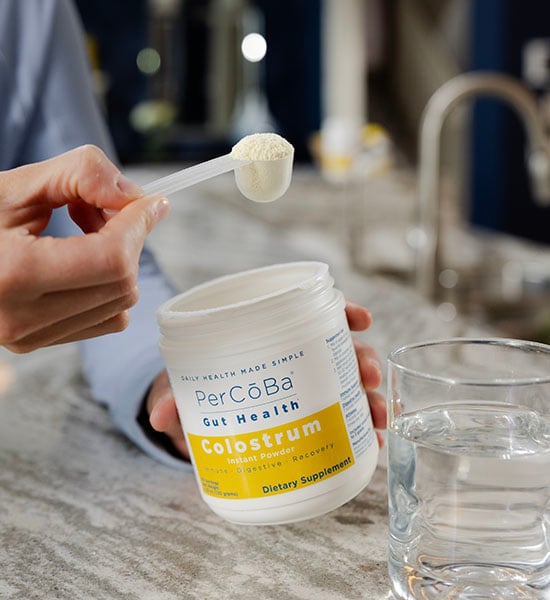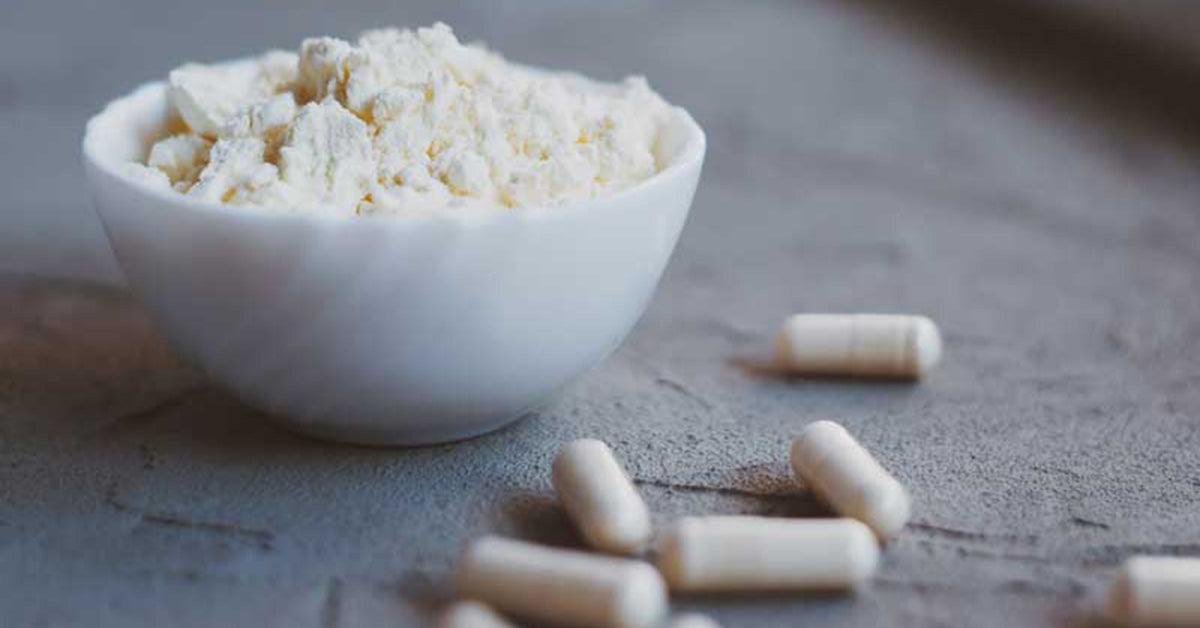There are more than 90 described components in bovine colostrum. Although we are using categories, it should be noted that many of these factors have multiple functions and the classification into certain categories is not always distinct.
The information below is provided to give an understanding of various fractions contained in colostrum.
Immuno-regulating Substances
- Thymosin (alpha & beta chains). A hormone composed of two protein-based chains that are separately present in bovine colostrum. The chains act on the thymus gland independently or in concert with each other to stimulate activation, development and maintenance of the immune system.*
- Proline-rich peptide (PRP). A hormone-like small protein that acts upon the thymus and other organs associated with the immune system to keep it from over-reacting to an insult.*
- Cytokines. Small proteins produced by various cells in the body that induce the generation of specialized types of white blood cells, signal them to come to the site of an insult and help in their passage through tissues.*
- Lymphokines. Proteins of varying sizes that are produced by different types of white blood cells that tell related cells to transform themselves into more functional cell types that can release substances capable of destroying an invading microorganism.*
Gut Protective Substances
- Immunoglobulins (IgG, IgM, IgA). Complex proteins, better known as antibodies, that make up a significant portion of the proteins found in complete first milking colostrum. These antibodies were produced by the mother’s immune system in response to her exposure to many different microorganisms during her lifetime and then transferred into the colostrum prior to birth of the calf. These substances help support the gastrointestinal tract of humans.*
- Transfer factors. Small proteins produced in response to the body’s exposure to certain types of microorganisms, particularly those that reside in deep tissues for a long period of time. They are specific for a particular microorganism and are carried inside of certain types of specialized white blood cells. Transfer factors have limited effectiveness alone in defending the body against infection by such microorganisms, but, rather, act in concert with various white blood cells and other factors in an attempt to keep the microorganisms under control.*
- Lactoferrin. A mineral-binding carrier protein that attaches to available iron. Certain aerobic (grow in the presence of oxygen) bacteria, require iron to reproduce and, therefore, lactoferrin is an effective substance, when operating in the presence of a specific antibody, to impede the growth of some microorganisms in the gut.* Additional claims have been made by some providers of colostrum for human consumption regarding the application of lactoferrin as an immuno-regulating substance with antiviral, antibacterial and anti-tumor properties. To date, none of these claims have been adequately substantiated through properly controlled
- Transferrin. Another mineral-binding carrier protein that attaches to available iron and can act independently or in concert with lactoferrin to impede the growth of certain aerobic bacteria, particularly in the gut.*
- Lysozyme. A very powerful enzyme that is capable of attaching itself to the cell wall of certain pathogenic bacteria and degrading select components, leaving holes in the wall of the bacteria.
- Lactoperoxidase. A mildly effective enzyme that can also attach to the wall of certain bacteria, degrade selected proteins and interfere with the ability of the bacteria to replicate themselves.
- Xanthine Oxidase. Another mildly effective enzyme that can also attach to the wall of certain bacteria, degrade different proteins than those affected by lactoperoxidase and, therefore, also interfere with the ability of the bacteria to replicate themselves.
- White blood cells (leukocytes). Primarily, three types of functional white blood cells are present in colostrum, including neutrophils, macrophages and polymorphonuclear cells. Each has the ability to phagocytize (engulf) microorganisms and other foreign bodies and apply substances carried internally to the destruction of the microorganisms. Their functions are dramatically enhanced when antibodies first attach to the microorganisms.*
- Oligosaccharides and glycoconjugates. Complex carbohydrates (sugars) that can adhere to specific sites on the inner surface of the gastrointestinal tract and prevent the attachment of microorganisms.*
The Growth Factors
-
Insulin-like growth factors (IGFs). Insulin-like growth factor-1 (IGF-1) and its closely related counterpart insulin-like growth factor-2 (IGF-2) are potent hormones that are found in association with almost all cells in the body. They are part of a group of more than 90 different proteins, called the “IGF Binding Protein (IGFBP) Superfamily”, that is responsible for the processes by which cells grow and reproduce. These substances are also responsible for maintenance of the metabolic pathways in the body by which cells convert glucose to glycogen, a primary energy resource, and use amino acids to create proteins. The key event that triggers the functions of the various proteins in the IGFBP Superfamily is the attachment of IGF-1 to a specific site on the surface of a cell. Many of the growth factors found in colostrum and previously defined by their functions are now considered part of the IGFBP Superfamily. This includes the following substances, among others.
- Transforming growth factors A & B. Induces the transformation of cells from an immature form to a mature, functional status.
- Epithelial growth factor. Involved in the generation and maintenance of cells in the epithelial (outer) layers of the skin.
- Fibroblast growth factor. Associated with the regeneration of various types of tissue, including skin and other organs.
- Platelet-derived growth factor. Responsible for the generation of cells and functions associated with blood clotting.
The Metabolic Factors
- Leptin. A small hormone-like protein that can suppress appetite. Mature fat cells (adipocytes) release leptin in the presence of insulin, which is also found in colostrum. Insulin-producing pancreatic beta-cells have binding sites for leptin, and it is believed that the size of fat cells may be a major factor in determining the amount of leptin released.*
- Insulin. A hormone required for the effective utilization of glucose (blood sugar) in the body. Insulin binds to specific sites on cells, facilitating their interaction with IGF-1 and, thus, initiating the conversion of glucose to glycogen, a high energy source carbohydrate.*
- Vitamin-binding proteins. Smaller proteins that act as carriers to deliver B-complex vitamins to the body. Carrier proteins and the associated vitamins folate (B6), B12 and orotic acid are found in colostrum.
- Mineral-binding proteins. The iron-binding proteins, lactoferrin and transferrin, have already been discussed above. In addition to interfering with the replication of certain microorganisms, they also serve to capture iron from the ingested food and present it in a form that can readily be absorbed by the body. Lactoferrin can also bind copper and deliver it in a form suitable for absorption by the body. In addition, there are two carrier proteins in colostrum that assist in the absorption of calcium. They are casein, and alpha- lactalbumin, which is present in colostrum very soon after birth.
- Cyclic adenosine monophosphate (cAMP). A phosphorylated nucleotide in a very specialized form that transfers the chemical energy necessary to drive metabolic reactions to form new protein, carbohydrate and fat molecules.
- Enzyme inhibitors. These small proteins slow down or inhibit the breakdown of proteins by certain enzymes. They provide limited protection to the immune, growth and metabolic factors as they pass through the digestive tract.*
There are many other substances present in colostrum, but some are not well understood. However, there are at least two substances in addition to those described above that do have understood function. They are the hormone melatonin, which has a direct effect on the establishment of biological rhythms and proper sleep patterns; and relaxing, a hormone known to directly affect contracted muscles.*



